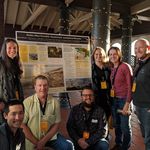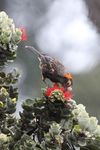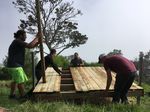Kiwikiu news - Maui Forest Bird Recovery Project
←
→
Page content transcription
If your browser does not render page correctly, please read the page content below
S emi Ann ual R epo rt S p rin g 2 019
Kiwikiu
Kiwikiu Reintroduction Plan
news
Kiwikiu (Maui Parrotbill; Pseudonestor xanthophrys) are among the rarest
and most endangered birds in Hawai‘i. Because of this, US Fish &
Wildlife Service has recommended establishing a second population on
the leeward slope of Haleakalā to increase total population size and
protect the species from severe weather events or other catastrophic loss
in their small current range. Nakula Natural Area Reserve (NAR) on the
leeward slope of Haleakalā was selected as the site of the first releases of
Kiwikiu to begin establishing a second population.
Kiwikiu were once found in this area, but the forests were degraded from a
history of introduced ungulate impact. However, large, intact forest
sections remain and the majority of this habitat is now either fenced or will
be shortly. Following fencing and eradication of ungulates, the forest in
this area has begun to recover through natural regeneration and
conservation restoration efforts (see page 3).
In 2018, the Maui Forest Bird Working Group* completed the Kiwikiu
Reintroduction Plan. The plan outlines the steps of establishing Kiwikiu on
the leeward slope, including the procedures for the first year of releases in
Nakula. Here is a short summary:
Cohort for release will consist of 12 wild and 8 captive individuals. Captive birds consist of seven males and one female;
therefore a release of more males than females is very likely. Wild individuals will be caught in Hanawi Natural Area Reserve.
Soft Release Technique: All 20 birds will be held in paired aviaries at 10 sites within Nakula. Birds will be held for up to 3
weeks. Aviaries will be opened to release birds to site incrementally to help anchor birds to the area.
Food supplementation will be provided in and around the aviaries as long as the birds need.
Post-release monitoring will use radio transmitters and color-band resighting.
This is the first step of a multi-year effort. Following the first year, the results will be evaluated to determine if, and in what
ways, additional releases should be conducted. The short term goal is to create a disjunct population of Kiwikiu that survives multiple
years. The ultimate goal is to establish a self-sustaining population of Kiwikiu in Kahikinui.
*Maui Forest Bird Working Group is made up of these organizations: American Bird Conservancy, Haleakalā National Park, Leeward Haleakalā Watershed Restoration
Partnership, Maui Forest Bird Recovery Project, National Park Service Inventory & Monitoring, Pacific Bird Conservation, Pacific Cooperative Studies Unit, San Diego Zoo
Global, State of Hawai‘i Department of Land & Natural Resources – Forestry & Wildlife, State of Hawai‘i Department of Land & Natural Resources – Native Ecosystems
Protection & Management, The Nature Conservancy of Hawai‘i, US Fish & Wildlife Service, and US Geological Survey - Biological Resources Division.
Kiwikiu Facts:
Specialized insectivorous Hawaiian honeycreeper.
Endangered:KIW IKIU NEW S page 2 S emi Ann ual R epo rt S p rin g 2 019
Avian Research & Management Update
Our focus this year has been on preparing for
the Kiwikiu reintroduction to Nakula Natural
Area Reserve. We presented a poster on the
Kiwikiu Reintroduction Plan at the IUCN
Wildlife Reintroduction Conference in
Chicago, which can be viewed here: Kiwikiu
Recovery Wildlife Reintroduction Conference
Poster. You can view more papers and
presentations on our website.
In addition to planting and restoring habitat in
Nakula, we built wooden platforms for
aviaries to be installed on, to house Kiwikiu
as they acclimate to their new home in Nakula. We also started predator control in the
area to reduce the numbers of predators prior to the Kiwikiu release.
Diet Studies Using Fecal Samples
While mist netting and banding birds, we oftentimes will collect fecal
samples. Whenever a bird is caught, it is carried in a cloth bag and
sometimes while in the bag, the bird will defecate and we collect the
sample. It is important to collect these fecal samples because it
allows us to conduct diet analyses like the one by Peck et al. 2015.
We can assess what food resources and plants the birds need to
thrive. Also important is looking at diet overlap with non-native birds,
a possible graduate research project. MFBRP has samples dating
as far back as 1993. Though most of them were collected at multi-
ple sites annually starting in 2009. Sites include The Nature Con-
servancy’s Waikamoi Preserve, Hanawi Natural Area Reserve
(NAR), Nakula NAR, Kula Forest Reserve, Waihe‘e Ridge Trail,
Garden of Eden, and Kipahulu Preserve. The graph portrays the
number of individuals that MFBRP has collected samples from, not
the total number of fecal samples collected.
Rapid ‘Ōhia Death (ROD) on Kaua‘I
At the end of 2018, Ceratocystis lukuohia, a fungal pathogen causing ROD was found during a survey on
Kaua‘i. This now means that both pathogens, C. lukuohia and C. holiohia are found on Kaua‘i. Aerial
surveys by helicopter and drones are conducted on the islands to survey the distribution and severity of
the disease. Discussion of these surveys is located here and Kaua‘i Invasive Species Committee.
Both C. lukuohia and C. holiohia typically enter a wound of a tree, i.e. broken branch or scuffed exposed
root. C. lukuohia can kill a tree within weeks while C. holiohia can take months. Both will be noticeable in
trees through browning of limbs or the crown. Since there is no cure for ROD, prevention has become the
first line of defense against further spread. While ROD has not been found on Maui yet, here some good
steps to follow:
Avoid injuring ‘ōhia. This includes pruning.
Clean off your gear and equipment, including shoes and clothes, before and after entering are-
as with ‘ōhia. Clean by brushing off soil and seeds; then spray with 70% rubbing alcohol. Wash clothes with hot water & soap.
Wash your vehicle with a high-pressure hose or washer, especially on and around the tires and the vehicle undercarriage.
Do not move ‘ōhia wood around. If it is infected, moving the wood could spread the pathogens.
If you see a tree possibly infected (limb or crown leaves turning brown), take a picture and contact 643-PEST or 643PEST.com.
Do not try to take a sample, as trained technicians must sample the wood and test it themselves.
MAUI FOREST BIRD RECOVERY PROJECT—2465 OLINDA ROAD MAKAWAO, HI 96768 office: 808.573.0280
www.mauiforestbirds.org info@mauiforestbirds.orgKIW IKIU NEW S page 3 S emi Ann ual R epo rt S p rin g 2 019
Nakula Forest Restoration Update
Plot Monitoring and 5-year Update:
By the end of 2012, the State of Hawai‘i had eradicated ungulates from a sizable
section of Nakula NAR. These animals had munched and trampled the forest for >150
years. One of the goals for Nakula was to restore the forest. At that time, we did not
know what level of intervention would be required to expand and enhance the
remaining Nakula forest. Would we be able to let nature repair itself? Would we have to
plant nursery-raised seedlings? Would these seedlings even survive? To answer these
and other questions, MFBRP conducted experimental restoration trials in Nakula
between 2013-2015. Check out the recently published report .
We also just monitored the same experimental plots at the five-year mark and are
preparing a report on those findings. Through these trials we learned a few important
things. Naturally germinating native seedlings were largely restricted to two species,
‘a‘ali‘i and koa. However, these two have transformed huge sections of Nakula from a
grassland with scattered, ancient koa to a burgeoning forest. Unfortunately non-native
grasses (like kikuyu) grow densely and limit germination of native plants. In the trials,
we experimented with removing the grasses using herbicide and weed-whackers. We
found that by completely removing the grass and exposing the topsoil, we can
stimulate nearly 20× more ‘a‘ali‘i seedlings to come up on their own than without
intervention. Given that only two species account for most of the natural regeneration,
it became clear that planting nursery-grown seedlings was going to be needed in order
to diversify the forest. Given the time, money, and effort it takes to plant in such a
remote location, we were thrilled to see that two-year survivorship in experimental plots
was over 80%. Our recent monitoring revealed a drop in survivorship in some species,
likely owing to grass competition, but overall survivorship remains over 71% after five
years! The benefits of applying herbicide to reduce grass prior to planting was even
more evident after five years, particularly in growth rates. For example, koa planted in treated plots, where grass was removed,
>60% of seedlings were taller than 4 m, while only 30% reached this height in plots without grass control. At this size, these
“seedlings” no longer deserve that name, they are trees that tower over our heads!
It’s hard to express to people who haven’t seen the process over the past six years exactly what Nakula was like just after the
ungulates were removed. There was a time when we would exclaim over the sighting of a lone seedling. Now, we have to push
our way through dense
‘Iliahi (Santalem haleakalae) or Hawaiian Sandalwood is an patches of young koa and
important tree species that we’ve planted in Nakula. ‘Iliahi was
heavily harvest in the early 1800’s for trade, for its fragrant ‘a‘ali‘i. There is a long way
smell and wood. Due to this it is not as common as it once to go to returning Nakula to
was. It is scattered across the alpine shrubland, in places like its former glory. But, hey,
Haleakalā National Park, Kula Forest Reserve, and Nakula.
it’s only been six years! In
‘Iliahi are hemi-parasitic and need a host plant to help them
grow. Through special roots, they take nutrients from the host, March, we surpassed
though there may be shared benefits. When planting, we make 65,500 native seedlings!
sure ‘Iliahi have a “buddy”, usually a seedling near by.
Mahalo!
Thank you to our volunteers & partners who helped in Nakula September 2018-March 2019:
Lawrence Warnock, Becky Geelhood, Duncan Yeaman, Alex Lake, Andy Fox, Nora Ives, Meghan Hernandez,
Cody Roberts, Dan Rezac, Jessica Middleton, Kristin Markham, Dan Markham, Eric Hamren
MAUI FOREST BIRD RECOVERY PROJECT—2465 OLINDA ROAD MAKAWAO, HI 96768 office: 808.573.0280
www.mauiforestbirds.org info@mauiforestbirds.orgKIW IKIU NEW S page 4 S emi Ann ual R epo rt S p rin g 2 019
Project Support & Partnerships Events
New Project Support & Grants Check out events page for full list.
MFBRP was lucky to receive some major support in
the last few months. Thank you to the following new
supporters (receiving over $10,000 in funds towards
Kiwikiu Recovery): Disney Conservation Fund,
Doolin Foundation for Biodiversity. Fred Baldwin
Memorial Foundation also gave us a $5,000 grant to
help plant more seedlings in Nakula.
Additionally we would like to mention that Kiwikiu
recovery efforts and plans have been funded by the
State Department of Land & Natural Resources, US
Fish & Wildlife Service, American Bird Conservancy,
National Fish and Wildlife Foundation, Disney
Conservation Fund, San Diego Zoo Global,
Mohamed bin Zayed Species Conservation Fund,
Patagonia, Tri-Isle RC&D Council, Inc., and Nā Koa
Manu Conservation, Inc.
Unique Maui Tours
Unique Maui Tours has been supporting Maui Forest Bird Recovery Project
since Delphine Beribigier started the adventure tour company on Maui.
Delphine is a Certified Interpretive Guide from the National Association of
Interpretation. Delphine is passionate about sharing her knowledge and
appreciation of Maui and the Hawaiian culture and environment on her tours.
She sponsors a tree for every tour, by supporting MFBRP’s planting efforts.
They are members of the Hawaii Ecotourism Association, support other
environmental organizations like Hawaiian Islands Land Trust, and use
environmentally friendly products like stainless steel water bottles and utensils
on the tours.
Aloha to KJ Passaro, Field Associate with MFBRP. He will be joining the State of Hawai‘i Department of
Land and Natural Resources-Division of Forest & Wildlife team. We wish him luck on his next move in
conservation. Continue the good work!
E komo mai to our Kupu Conservation Leader, Kristi Fukunaga. Mahalo to all our volunteers, donors, and
supporters. One volunteer received the President's Volunteer Service Award: Lawrence Warnock. This award is
given to volunteers who give over 100 hours of their time over a 12-month period.
MAUI FOREST BIRD RECOVERY PROJECT—2465 OLINDA ROAD MAKAWAO, HI 96768 office: 808.573.0280
www.mauiforestbirds.org info@mauiforestbirds.orgYou can also read


























































